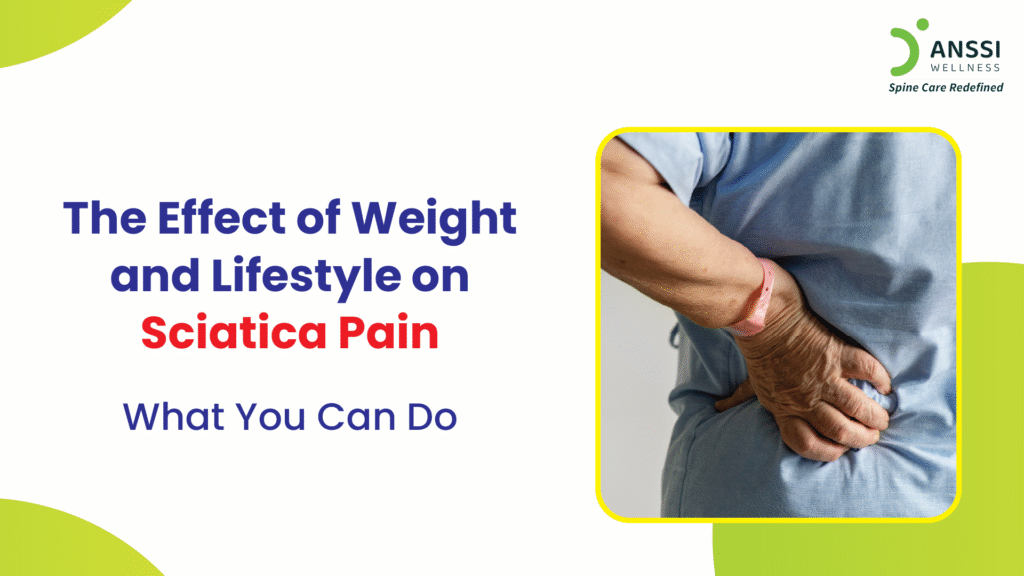Sciatica is one of the most common causes of lower back and leg pain among adults today. It occurs when the sciatic nerve, the longest nerve in the body, becomes compressed or irritated, leading to sharp pain that radiates from the lower back down to one or both legs.
While sciatica can result from conditions like a herniated disc, spinal stenosis, or degenerative disc disease, lifestyle factors such as obesity and inactivity often play a crucial role in worsening the symptoms.
The good news? By making mindful changes to your weight and daily habits, you can effectively manage and even prevent sciatic pain without surgery.
How Excess Weight Impacts Sciatica
Carrying extra weight, especially around the abdomen, places additional stress on the lumbar spine. Every extra kilogram of body weight increases the load the spine must support. Over time, this constant pressure can lead to disc degeneration, herniation, or inflammation around the sciatic nerve.
Obesity also affects posture:
- Excess abdominal fat pulls the pelvis forward, exaggerating the lumbar curve and increasing the risk of nerve compression.
- Moreover, higher body fat levels promote chronic inflammation throughout the body, which can worsen nerve pain and slow down the healing process.
In simple terms, maintaining a healthy weight is not only about appearance; it’s about preserving spinal health. When the spine carries less load, the discs and nerves are less likely to get irritated or compressed.
Lifestyle Factors that Aggravate Sciatica
Modern sedentary habits are one of the biggest contributors to sciatica flare-ups. Sitting for long hours, especially in poor posture, weakens the core and gluteal muscles that support the spine. This muscular imbalance places undue pressure on the lower back and increases the likelihood of sciatic nerve irritation.
Poor ergonomics, such as slouching on a couch, sitting on soft chairs without lumbar support, or working on improperly aligned screens, further worsen spinal stress. The result? Increased tension and inflammation around the lower back.
Additionally, habits like smoking and inadequate hydration affect spinal disc health. Smoking reduces oxygen supply to spinal tissues, accelerating degeneration, while dehydration reduces the cushioning capacity of intervertebral discs. Poor nutrition, particularly diets high in sugar and processed foods, also fuels inflammation and delays recovery.
In short, a sedentary and unhealthy lifestyle sets the stage for both the onset and persistence of sciatica pain.
Lifestyle Changes for Sciatica Relief
Addressing lifestyle-related factors can drastically improve your comfort and quality of life.
1. Maintain a Healthy Weight
Losing even a small amount of excess weight can significantly reduce spinal pressure. Focus on gradual, sustainable weight loss through balanced eating and regular exercise. Choose whole foods such as vegetables, fruits, lean proteins, and whole grains. Avoid processed snacks and sugary beverages that trigger inflammation.
2. Stay Active
Low-impact exercises like swimming, brisk walking, and cycling improve blood flow, strengthen back-supporting muscles, and ease stiffness. Gentle yoga and stretching also help maintain spinal flexibility and reduce nerve compression. However, high-impact activities or heavy lifting should be avoided during flare-ups.
3. Improve Posture and Sitting Habits
Invest in an ergonomic chair that supports your lower back. Keep both feet flat on the floor, shoulders relaxed, and computer screens at eye level. Avoid crossing your legs or sitting for more than 30–45 minutes at a time. Take short breaks to stretch and walk around.
4. Practice Core Strengthening
A strong core stabilizes the spine and reduces strain on the lower back. Simple exercises like pelvic tilts, bridges, and gentle planks can strengthen these muscles without aggravating pain.
5. Prioritise Hydration and Nutrition
Drink plenty of water throughout the day to keep spinal discs hydrated. Incorporate anti-inflammatory foods like turmeric, nuts, olive oil, and omega-3-rich fish into your meals. Limit caffeine and processed foods that can deplete nutrients essential for nerve health.
Non-Surgical Treatment Options for Sciatica
While lifestyle adjustments are foundational for sciatica relief, non-surgical medical treatments can provide targeted recovery for those with chronic or severe pain.
Non-Surgical Spinal Decompression Treatment is one of the most advanced and effective methods to relieve pressure on the sciatic nerve. This treatment uses a specialized traction table that gently stretches the spine, creating space between compressed vertebrae. This process improves nutrient flow to damaged discs, reduces nerve impingement, and promotes natural healing, all without surgery, injections, or medication.
In addition, physiotherapy plays a supportive role in recovery by helping patients retrain their posture, strengthen stabilizing muscles, and restore mobility. Other complementary approaches, such as heat therapy, gentle chiropractic adjustments, and guided stretching, can further aid in pain management and prevention.
About ANSSI:
ANSSI Wellness focuses on improving the quality of life for patients suffering from spinal issues, aiming to provide relief where other conventional treatments have failed. Through advanced Non-Surgical Spinal Decompression Treatment, ANSSI is committed to helping patients avoid surgery and recover in a safe, effective, and compassionate environment.
Connect with ANSSI Wellness on LinkedIn, Instagram, and Facebook for expert guidance.




